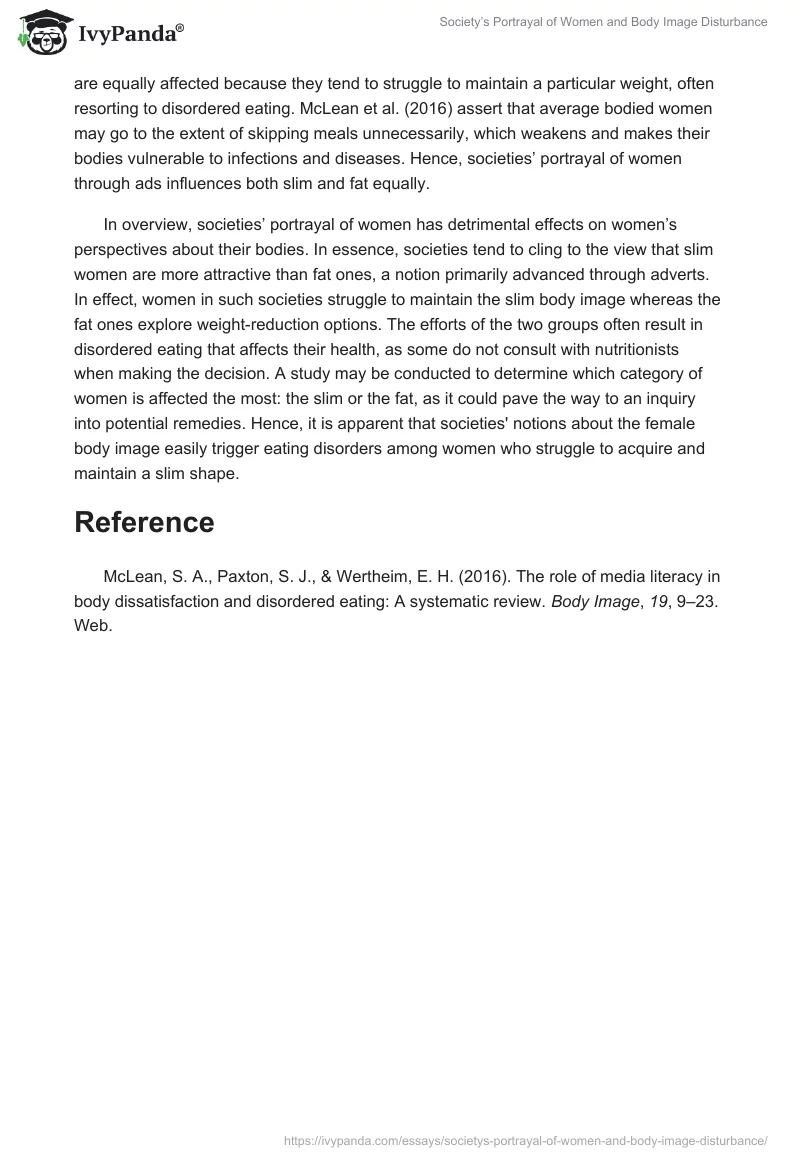Women are reportedly highly vulnerable to media influence, which explains why they are among marketers’ key target groups. McLean et al. (2016) assert that marketers and advertisers have successfully created an unfounded notion that the slim and tall woman is the perfect female body. In my view, this outlook is primarily advanced through ads featuring slim model women, even for products that have little to no connection to a particular gender. Societies have since adopted and embraced body image notions, often manifested in different functions, such as contests where beauty is gauged based on whether one is slender. Unfortunately, these notions have far-reaching implications on women’s view of self, especially if they do not fit the presumed perfect body image. Some resort to disordered eating to maintain a particular size and shape even when their body energy needs require otherwise.
The presumption that fat women are less attractive, as is largely cultivated by the unfounded narrative that the slim shape is the basic factor of beauty, often causes body image disturbances. McLean et al. (2016) posit that one can easily find ready remedies for beauty concerns, such as the use of makeups, beautiful dresses, and fashionable hairstyles to boost their appearance. The situation is different and challenging in the case of body image and shape. Short and big-bodied women tend to feel helpless and would do anything to lose weight. I think this assertion is true, considering that individuals struggling to lose weight can easily indulge in disordered eating if they fail to consult with nutritionists and other experts. Resultantly, they adopt unchecked eating habits that lead to malnutrition or over-consumption of high-energy foods in small portions.
Societies propagate the narrative that a woman has to be slim through popular media in different forms, leading to adverse notional effects. The use of slim women on food and beverage ads is a common trend. Often, these ads mislead the target audience into thinking that the consumption of advertised foods or beverages helps in maintaining the perfect body image (McLean et al., 2016). The same people struggling to reduce weight become victims of misleading adverts. They consume unhealthy products, usually processed foods with high-calorie content. In my view, slim women are equally affected because they tend to struggle to maintain a particular weight, often resorting to disordered eating. McLean et al. (2016) assert that average bodied women may go to the extent of skipping meals unnecessarily, which weakens and makes their bodies vulnerable to infections and diseases. Hence, societies’ portrayal of women through ads influences both slim and fat equally.
In overview, societies’ portrayal of women has detrimental effects on women’s perspectives about their bodies. In essence, societies tend to cling to the view that slim women are more attractive than fat ones, a notion primarily advanced through adverts. In effect, women in such societies struggle to maintain the slim body image whereas the fat ones explore weight-reduction options. The efforts of the two groups often result in disordered eating that affects their health, as some do not consult with nutritionists when making the decision. A study may be conducted to determine which category of women is affected the most: the slim or the fat, as it could pave the way to an inquiry into potential remedies. Hence, it is apparent that societies’ notions about the female body image easily trigger eating disorders among women who struggle to acquire and maintain a slim shape.
Reference
McLean, S. A., Paxton, S. J., & Wertheim, E. H. (2016). The role of media literacy in body dissatisfaction and disordered eating: A systematic review. Body Image, 19, 9–23. Web.


